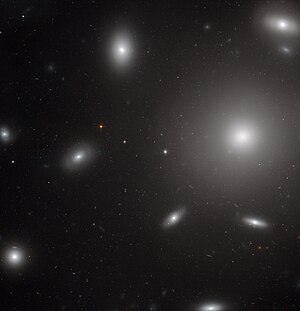NGC 4874
| Galaxy NGC 4874 |
|
|---|---|

|
|
| High-resolution image of part of the Coma galaxy cluster, NGC 4874 can be seen dominating in the middle right. Created using the Hubble Space Telescope . | |
| AladinLite | |
| Constellation | Berenike's hair |
|
Position equinox : J2000.0 , epoch : J2000.0 |
|
| Right ascension | 12 h 59 m 35.7 s |
| declination | + 27 ° 57 ′ 33 ″ |
| Appearance | |
| Morphological type | cD; Di |
| Brightness (visual) | 11.9 likes |
| Brightness (B-band) | 12.9 mag |
| Angular expansion | 1.9 ′ × 1.9 ′ |
| Surface brightness | 13.4 mag / arcmin² |
| Physical data | |
| Affiliation | Coma Pile Abell 1656 |
| Redshift | (23937 ± 10) · 10 −6 |
| Radial velocity | (7176 ± 3) km / s |
|
Stroke distance v rad / H 0 |
(321 ± 23) x 10 6 ly (98.5 ± 6.9) Mpc |
| history | |
| discovery | Heinrich Ludwig d'Arrest |
| Discovery date | May 5, 1864 |
| Catalog names | |
| NGC 4874 • UGC 8103 • PGC 44628 • CGCG 160-231 • MCG + 05-31-70 • 2MASX J12593570 + 2757338 • GC 5695 • LDCE 0926 NED047 | |
NGC 4874 is a very large elliptical galaxy from the Hubble type cD in the constellation Coma Berenices the northern sky , the 321 million light-years from an estimated Milky Way is removed. The galaxy is about ten times larger than the Milky Way and is located in the center of the Coma galaxy cluster , in its halo there are over 30,000 globular clusters .
It is of the cD galaxy type and dominates - together with a second giant galaxy called NGC 4889 - the gravity field of the galaxy cluster . The two star systems are very old and probably arose from the merging of several small spiral galaxies .
The object was discovered on May 5, 1864 by the German-Danish astronomer Heinrich Ludwig d'Arrest .
Web links
- Spitzer space telescope
- The Coma heap (with picture from the Palomar Sky Survey), University of Munich
- astronews.de: Picture of the day September 20, 2011
- Auke Slotegraaf: NGC 4869. Deep Sky Observer's Companion, accessed on February 18, 2015 .
